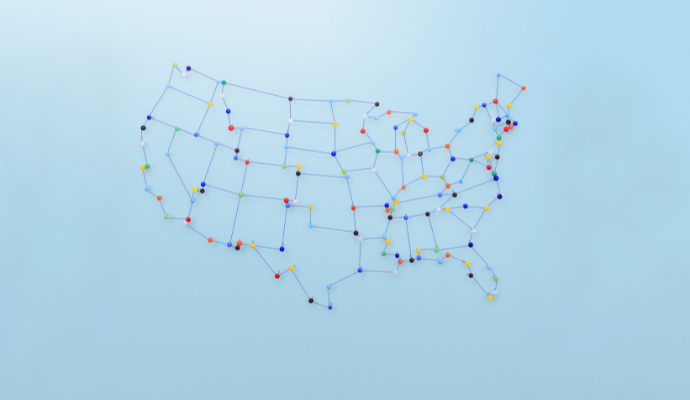Abortion Access Shifts as States Without Bans Absorb Patient Needs
Abortion access in restriction states plummeted by 114,590 in the first year after the Dobbs decision, while it increased in non-restriction states by nearly 117,000 procedures.

Source: Getty Images
- The impact of the Dobbs vs. Whole Women’s Health Supreme Court decision is starting to be felt nationwide, as new data from the Society for Family Planning shows that abortion access went down in states that restrict the procedure and up in states that do not.
These findings, published in the Society for Family Planning’s #WeCount report, could call into question the sustainability of abortion access when patients have to travel to different states to get the procedure.
The 2022 Dobbs decision virtually ended Roe v. Wade, setting off a series of trigger laws across the country that restrict access to abortion. Some of these bans, which for the report were categorized as six-week or near-total bans, carry with them civil and criminal penalties. Due to ongoing litigation challenging these laws, the Society for Family Planning researchers said it can be difficult for individuals to keep up with restrictions.
That means some people seeking abortions opt not to access one in states where bans exist or are in legal limbo and instead go to states where abortion access has no or limited restrictions.
“A year after the Supreme Court overturned Roe v. Wade, abortion access in the United States plummeted to zero in some states while increasing to meet the acute need in others, leading to a complete disruption in the healthcare system and people’s lives,” Dr. Ushma Upadhyay, #WeCount co-chair and professor at the University of California, San Francisco’s Advancing New Standards in Reproductive Health (ANSIRH), said in a press release. “Our ability to access safe and effective healthcare should not be contingent upon the state in which we live or our ability to travel for necessary care.”
READ MORE: Abortion Bans with Exceptions Still Limit Patient Care Access
In particular, states with six-week or near-total abortion bans saw abortion access plummet by 114,590 procedures between July 2022 and June 2023 compared to baseline data from April and May 2022. That shakes out to 94,930 fewer abortions in states with near-total bans and 19,660 fewer abortions in states with six-week bans.
The states with the biggest decreases in abortion access include Texas (36,970 procedures), Georgia (19,660 procedures), Tennessee (13,930 procedures), Louisiana (9,110 procedures), Alabama (7,620 procedures), and Wisconsin (7,260 procedures).
Conversely, in states where abortion remained legal after six weeks, abortion access increased by a cumulative 116,790 procedures. The largest increases happened in Illinois (21,500 procedures), Florida (20,460 procedures), North Carolina (11,830 procedures), California (8,810 procedures), and New Mexico (8,640 procedures).
These states are sometimes referred to as surge states because they have absorbed surges of patients seeking abortion but who cannot in their home states. The report authors said states in the Southeast are more likely to see surges in patients because they often border states with more stringent abortion restrictions.
States in the Northeast and Northwest, plus other states that do not border restriction states, proved less likely to face these same types of surges.
READ MORE: 6-Week Abortion Bans Could Limit Care Access for 90% of People in Need
The report authors pointed out that states like Florida and North Carolina are considering abortion restrictions, which would end their status as surge states and would endanger patient access to abortion care.
The report also accounted for abortions provided via telehealth or virtual-only clinics, which can help patients in abortion-restriction states access the procedure in some cases. Overall, the researchers reported a 72 percent increase in the number of abortions provided by virtual care clinics. Before the Dobbs decision, virtual care abortions represented 5 percent of all abortions; after the decision, that number ticked up to 8 percent.
This data begs the question: how sustainable is abortion access in another state? While the data shows that patients are currently traveling to other states when they cannot access an abortion in their own state, the demand of that travel—plus the strain these surges may place on the clinics themselves—may not be tenable in the long-term, although the report could not dig specifically into that topic.
Indeed, travel distances have proven a key barrier to abortion care, separate studies have shown.
Ahead of the 2022 Dobbs decision, researchers found that travel distances led to key challenges barring patients from accessing an abortion they need. For example, patients living far away from an abortion provider said it would be hard to gather the money for travel expenses. These led some to delay or entirely forgo getting an abortion they needed.
That is not to mention the strain that surges of patients can have on clinics in states where abortion is legal, according to Amber Gavin, the vice president of advocacy and operations at A Woman’s Choice, an independent abortion clinic in Florida and North Carolina.
“The impact of the Dobbs decision is just as devastating as we expected,” Gavin said in a public comment on the Society for Family Planning report. “Clinics are striving to meet the needs of people from within our own state, and we’ve had a huge influx of people traveling from out of state to get abortion care. With new restrictions in North Carolina and a potential six-week ban looming in Florida, I’m not sure where all the people seeking abortion care in the Southeast will turn.”
